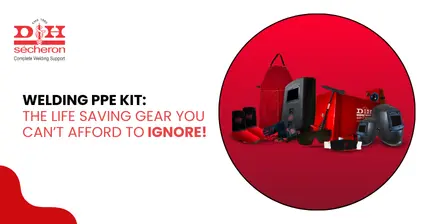Low Alloy Steel Welding in Pre-Engineered Building Structures: Strength, Durability, and Versatility
Pre-engineered buildings and structures have emerged as a modern alternative to conventional construction. They use a combination of structural steel framing systems, metal roofing systems, and wall panels of different materials. Their components are designed at a manufacturing unit and then assembled at the construction site.
Their major applications are found in power plants, refineries, petrochemicals, and fertilizer plants to build warehouses, storage units, and small retail and commercial offices. They are also used for houses, living shelters, aircraft hangers, supermarkets, and petrol pumps.
Some of the reasons why pre-engineered buildings and structures are becoming popular are:
- Cost-effectiveness
- Reduction in construction time
- Versatility in architectural design
- High customization
- High durability
- Low-maintenance
- Sustainable
- Flexibility of expansion
All the benefits mentioned above are primarily due to the use of low alloy steel in construction. While there are as many as 3500 different grades of steel with unique properties, it is the low alloy steel that is mostly used in pre-engineered structures.
Understanding Low Alloy Steel
Low alloy steel is a type of metal mixed with a composition of steel and other metals such as copper, chromium, phosphorus, and nickel. It contains about 1-5% of alloying elements. The percentage of composition usually depends on the preferred mechanical properties the welder wants to get.
Low alloy steel grades list has the following classification:
Low carbon quenched and tempered steels
Bearing steels
Medium carbon ultra-high-strength steels
Heat-resistant chromium-molybdenum steels
High-strength low alloy steels provide better mechanical properties compared to carbon and other types of steel. In fact, high-strength low alloy steels can be substituted for other steels with minimal effort and redesign.
Benefits of High Strength Low Alloy Steel in Welding of Pre-Engineered Structures
- Rust and corrosion resistant
- High-yield strength
- Excellent strength-to-weight ratio
- Ability to withstand high temperatures
- Ductile and flexible
- Non-combustible and fire-resistant
- Oxidation resistant
- Hydrogen resistant
When properly designed and constructed, alloy steel can provide much-needed strength and durability to pre-engineered structures due to its properties. However, it is crucial to that use the right welding electrode for low alloy steel.
Flux Cored Arc Welding (FCAW) and Submerged Arc Welding (SAW) are commonly used welding methods in the construction of pre-building structures. If you are looking for low alloy consumables for these welding methods, you can explore various options D&H Secheron website. D&H Secheron is one of India’s leading welding consumables manufacturers. It offers a comprehensive range of welding solutions for every need, including pre-building structures.
11 May 2025 | Welding
An In-Depth Exploration of Low-Alloy Steel: Your Comprehensive Guide
11 May 2025 | Welding
Nagpur - Bori - Tuljapur Road MSH-3 in Yavatmal District (Maharashtra)
11 May 2025 | Welding
Guidelines to Understand Gas Welding: Applications, Advantages & Disadvantages
11 May 2025 | Welding
3 Tips for Finding the Best Mild Steel Electrode for Your Application
11 May 2025 | Welding
How to Select the Right Welding Filler Wires for Stainless Steel Welding?
11 May 2025 | Welding
Building the Narendra Modi Stadium with Norma V and Autotherme-1 Electrodes
11 May 2025 | Welding
Welding Rods: Different Types and Tips for Properly Storing and Handling
11 May 2025 | Welding
Tips for Flawless Welds with Stainless Steel Electrodes: Pros and Cons
11 May 2025 | Welding
Exploring Applications and Benefits of Stainless Steel Welding Electrodes
11 May 2025 | Welding
Welding Basics: Joining Metals with Heat and Pressure - A Beginners Guide
11 May 2025 | Welding
Distinguishing Low-Alloy Steel from High-Alloy Steel: Understanding the Variations
11 May 2025 | Welding
Hard Facing Wire - Understanding the Process and Achieving Optimal Result
11 May 2025 | Welding
Exploring the Advantages of Stainless Steel Electrodes in Welding Applications
11 May 2025 | Welding
Weathering Steel vs. Traditional Steel: A Comparative Analysis of Performance
11 May 2025 | Welding
Choosing the Right Welding Rod: Why 6013 Electrodes Might Be Your Ideal Option
11 May 2025 | Welding
Why 7018 Electrodes Are Preferred for High-Strength Welds in Pipeline Construction
11 May 2025 | Welding
Filler Wire vs. Stainless Steel Filler Wire: Understanding the Key Differences
11 May 2025 | Welding
Exploring the Impact of Filler Material on Welding Quality and Durability
11 May 2025 | Welding
Choosing the Right Cast Iron Electrode for Different Welding Projects
11 May 2025 | Welding
Top Advantages of Cast Iron Electrodes for Industrial Welding Applications
11 May 2025 | Welding
Key Benefits and Challenges of Using TIG Welding in Industrial Projects
11 May 2025 | Welding
5 Reasons Why 7018 Electrode is the Gold Standard for Welding Professionals
11 May 2025 | Welding
Top 5 Advantages of Flux Cored Arc Welding for Heavy-Duty Applications.png)
11 May 2025 | Welding
Lotherme-601: A Game-Changer for Restoring Shoulder Pins in Heavy Machinery
11 May 2025 | Welding
How D&H Sécheron Helped Repair a Rotary Kiln’s Cooler Section with LoTherme 352
11 May 2025 | Welding
Piston Repair for Mining Industry: Cost-Effective Solutions with LoTherme 468.webp)







.jpg)








































.jpg)
.jpg)

.jpg)

.jpg)





.jpg)
.jpg)
.jpg)



.webp)
.jpg)
.jpg)
.webp)
.jpg)






















.png)



.webp)

.webp)
.webp)



